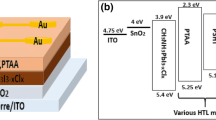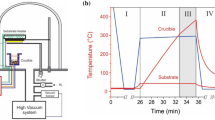Abstract
Different concentrations of NH4Cl are introduced to MAPbI3 precursor solution, planar MAPbI3 perovskite films, and solar cells’ performance with or without NH4Cl have been studied. The NH4Cl/MAPbI3 films exhibit increased grain size and narrowed grain boundaries. The light absorption of perovskite films with different concentrations of NH4Cl was also evaluated. To understand the growth of perovskite films with NH4Cl added to perovskite precursor solutions, XRD and XPS spectroscopy were conducted on different perovskite film samples. By adding NH4Cl, the MAPbI3 film shows good crystal quality and the shift of Pb peaks indicates that NH4Cl is not physically mixed but chemically incorporated into MAPbI3 films. We attribute the effect to Cl ions of NH4Cl combining with free lead ions of MAPbI3 so as to fill the vacancy of volatile I ions in the NH4Cl–MAPbI3 films. The 20 mg NH4Cl-based device showed an enhanced performance of a PCE of 13.67% compared to the device without adding NH4Cl with a PCE of 10.24%. The introduction of 20 mg NH4Cl achieved the best passivation effect. Using a 20 mg NH4Cl device, the trap density can be reduced to 0.84 × 1016 cm−3, resulting in more efficient charge removal from the surface and improved performance.



Similar content being viewed by others
Data availability
Data will be made available on request.
References
M. Chen, Y. Tang, R. Qin, Z. Su, F. Yang, C. Qin, J. Yang, X. Tang, M. Li, H. Liu, Perylene Monoimide Phosphorus Salt Interfacial Modified Crystallization for Highly Efficient and Stable Perovskite Solar Cells. ACS applied materials & interfaces. 15, 5556–5565, (2023).https://doi.org/10.1007/s11082-020-02342-4
S. Wang, Perovskite Tandem Solar Cell Technologies. Energies. 16, 1–3, (2023).https://www.mdpi.com/1996-1073/16/4/1586/
A.M. Elseman, M.M. Rashad, Influence of nitrogen atmosphere one-step heating assisted the solution processing of Kesterite Cu2ZnSnS4 as hole extraction on the efficacy of the inverted perovskite solar cells. Optical Materials. 124, 111998, (2022).https://doi.org/10.1016/j.optmat.2022.111998
P.M. Sonar, H.D. Pham, X. Li, W. Li, S. Manzhos, A.K.K. Kyaw, Organic Interfacial Materials for Perovskite-based Optoelectronic Devices. Energy & Environmental Science. 12, 1177–1209, (2019).https://doi.org/10.1039/C8EE02744G
L. Lin, P. Li, L. Jiang, Z. Kang, Q. Yan, H. Xiong, S. Lien, P. Zhang, Y. Qiu, Boosting efficiency up to 25% for HTL-free carbon-based perovskite solar cells by gradient doping using SCAPS simulation. Solar Energy. 215, 328–334, (2021).https://doi.org/10.1016/j.solener.2020.12.059
Z. Djuri, I. Joki, Ideal efficiency of resonant cavity-enhanced perovskite solar cells. Optical and Quantum Electronics. 52, 230, (2020).https://doi.org/10.1007/s11082-020-02342-4
N.K. Tailor, M. Abdi-Jalebi, V. Gupta, H. Hu, M.I. Dar, G. Li, S. Satapathi, Recent progress in morphology optimization in perovskite solar cell. Journal of Materials Chemistry A. 8, 21356–21386, (2020).https://doi.org/10.1039/D0TA00143K
G. Jang, H. Han, S. Ma, J. Lee, C.U. Lee, W. Jeong, J. Son, D. Cho, J.H. Kim, C. Park, Rapid crystallization-driven high-efficiency phase-pure deep-blue Ruddlesden–Popper perovskite light-emitting diodes. Advanced Photonics. 5, 016001, (2023).https://doi.org/10.1117/1.AP.5.1.016001
C.H. Chiang, M.K. Nazeeruddin, M. Gratzel, C.G. Wu, The synergistic effect of H2O and DMF towards stable and 20% efficiency inverted perovskite solar cells. Energy & Environmental Science. 10, 808–817, (2017).https://doi.org/10.1039/C6EE03586H
M. Loizos, M. Tountas, N. Tzoganakis, C.L. Chochos, A. Nega, A. Schiza, C. Polyzoidis, V.G. Gregoriou, E. Kymakis, Enhancing the lifetime of inverted perovskite solar cells using a new hydrophobic hole transport material. Energy Advances. 1, 312–320, (2022).https://doi.org/10.1039/D2YA00067A
X. Yuan, H. Li, J. Fan, L. Zhang, F. Ran, M. Feng, P. Li, W. Kong, S. Chen, Z. Zang, Enhanced p-Type Conductivity of NiOx Films with Divalent Cd Ion Doping for Efficient Inverted Perovskite Solar Cells. ACS applied materials & interfaces. 14, 17434–17443, (2022).https://doi.org/10.1021/acsami.2c01813
Y. Zhu, S. Wang, R. Ma, C. Wang, The improvement of inverted perovskite solar cells by the introduction of CTAB into PEDOT:PSS. Solar Energy. 188, 28–34, (2019).https://doi.org/10.1016/j.solener.2019.05.073
Q.B. Ke, J.R. Wu, C.C. Lin, S.H. Chang, Understanding the PEDOT:PSS, PTAA and P3CT-X Hole-Transport-Layer-Based Inverted Perovskite Solar Cells. Polymers. 14, 823, (2022).https://doi.org/10.3390/polym14040823
Z. Wang, J. Tao, J. Shen, W. Kong, Z. Yu, A. Wang, G. Fu, S. Yang, Multifunctional molecular incorporation boosting the efficiency and stability of the inverted perovskite solar cells. Journal of Power Sources. 488, 229449, (2021).https://doi.org/10.1016/j.jpowsour.2021.229449
S. Asgharizadeh, S.K. Azadi, M. Lazemi, Understanding the pathways toward improved efficiency in MXene-assisted perovskite solar cells. Journal of Materials Chemistry C. 10, 1776–1786, (2022).https://doi.org/10.1039/D1TC04643H
F. Gao, Y. Zhao, X. Zhang, J. You, Recent Progresses on Defect Passivation toward Efficient Perovskite Solar Cells. Advanced Energy Materials. 10, 1902650, (2020).https://doi.org/10.1002/aenm.201902650
W. Wanhai, Z. Jie, T. Weihua, Passivation Strategies of Perovskite Film Defects for Solar Cells. J. Inorg. Mater. 37, 129–139 (2022).https://doi.org/10.15541/jim20210117
R. Zhao, L. Xie, R. Zhuang, T. Wu, R. Zhao, L. Wang, L. Sun, Y. Hua, Interfacial Defect Passivation and Charge Carrier Management for Efficient Perovskite Solar Cells via a Highly Crystalline Small Molecule. ACS Energy Lett. 6, 4209–4219 (2021).https://doi.org/10.1021/acsenergylett.1c01898
Z. Yang, J. Dou, S. Kou, J. Dang, Y. Ji, G. Yang, W.Q. Wu, D.B. Kuang, M. Wang, Multifunctional Phosphorus-Containing Lewis Acid and Base Passivation Enabling Efficient and Moisture-Stable Perovskite Solar Cells. Advanced Functional Materials. 30, 1910710, (2020).https://doi.org/10.1002/adfm.201910710
K. Tang, S. Xie, G.R. Cofield, X. Yang, E. Tian, H. Lin, Catalytic transfer hydrogenation of furfural for the production of ethyl levulinate: Interplay of Lewis and Bronsted acidities. Energy Technol. 6, 1826–1831 (2018).https://doi.org/10.1002/ente.201700973
J. Xie, Z. Zhou, H. Qiao, M. Chen, L. Wang, S. Yang, Y. Hou, H. Yang, Modulating MAPbI3 perovskite solar cells by amide molecules: Crystallographic regulation and surface passivation. J Energy Chem. 56, 179–185, (2021).https://doi.org/10.1016/j.jechem.2020.07.050
J.S. Benas, F.C. Liang, W.C. Chen, Lewis adduct approach for self-assembled block copolymer perovskite quantum dots composite toward optoelectronic application: Challenges and prospects. Chemical Engineering Journal. 431, 133701, (2022).https://doi.org/10.1016/j.cej.2021.133701
Q. Yang, X. C. Wang, S. W. Yu, X. Liu, P. Gao, X. B. Hu, G. J. Hou, S. Q. Chen, X. Guo, C. Li, Solvent‐Actuated Self‐Assembly of Amphiphilic Hole‐Transporting Polymer Enables Bottom‐Surface Passivation of Perovskite Film for Efficient Photovoltaics. Advanced Energy Materials. 11(17), 2100493, (2021). https://doi.org/10.1002/aenm.202100493
A. Wincukiewicz, J.B. Jasinski, M. Tokarczyk, R. Pietruszka, M. Kaminska, The effects of doping and coating on degradation kinetics in perovskites. Solar Energy Materials and Solar Cells. 230, 111142, (2021).https://doi.org/10.1016/j.solmat.2021.111142
S. R. Pathipati, M. N. Shah, Performance enhancement of perovskite solar cells using NH4I additive in a solution processing method. Solar Energy, 162(3), (2018).https://doi.org/10.1016/j.solener.2017.12.043
G. F. Han, Hadi, et al. Additive Selection Strategy for High Performance Perovskite Photovoltaics.The journal of physical chemistry, C. Nanomaterials and interfaces, 122(25), 13884–13893, (2018). https://doi.org/10.1021/acs.jpcc.8b00980
P. Chen, W.J. Ong, Z. Shi, X. Zhao, N. Li, Pb-based halide perovskites: recent advances in photo (electro) catalytic applications and looking beyond. Adv. Func. Mater. 30, 1909667 (2020). https://doi.org/10.1002/adfm.201909667P
K.A. Parrey, S.G. Ansari, A. Aziz, A. Niazi, Enhancement in structural and optical properties of Cd doped hybrid organic-inorganic halide perovskite CH3NH3Pb1-xCdxI3 photo-absorber - ScienceDirect. Materials Chemistry and Physics. 241, 122387, (2020).https://doi.org/10.1016/j.matchemphys.2019.122387
W.W. Lin, J.R. Wu, Y. Nakanishi, L.C. Chen, Investigation on optoelectronic characteristics of porous silicon/TiO2/CH3NH3PbI3/graphene heterostructure light-emitting diodes prepared by spin-coating. Spie Nanoscience + Engineering.9558, 95580M, (2015).https://doi.org/10.1117/12.2187890
X. Wang, H. Sarvari, H. Dang, V. Singh, Z. Chen, Preparation and evaluation of perovskite solar cells in the absolute atmospheric environment. Spie/cos Photonics Asia. 10019, 100190B, (2016).https://doi.org/10.1117/12.2247659
Acknowledgements
We acknowledge the financial support from the National Natural Science Foundation of China (NSFC) (Nos. 61701261), the Natural Science Foundation of Jiangsu Province (Nos. BK20160417) and the Innovation and Entrepreneurship Training program for College students in Jiangsu Province of China (Nos. 202310304004Z).
Author information
Authors and Affiliations
Contributions
QY: Investigation, Methodology, Writing—original draft. FZ: Investigation, Writing. YT: Conceptualization. CP: Visualization. CW: Review. YJ: Review. MX: Writing—review and editing. TX: Review and Supervision.
Corresponding authors
Ethics declarations
Conflict of interest
The authors declare that they have no known competing financial interests or personal relationships that could have appeared to influence the work reported in this paper.
Ethical approval
The authors declare that this manuscript is original, has not been published before, and is not currently being considered for publication elsewhere. This submission in its present form is approved by all authors.
Additional information
Publisher's Note
Springer Nature remains neutral with regard to jurisdictional claims in published maps and institutional affiliations.
Rights and permissions
Springer Nature or its licensor (e.g. a society or other partner) holds exclusive rights to this article under a publishing agreement with the author(s) or other rightsholder(s); author self-archiving of the accepted manuscript version of this article is solely governed by the terms of such publishing agreement and applicable law.
About this article
Cite this article
Yin, Q., Zhang, F., Teng, Y. et al. Elimination of trap density by NH4Cl passivation for high-performance perovskite solar cells. Appl. Phys. A 129, 774 (2023). https://doi.org/10.1007/s00339-023-07047-5
Received:
Accepted:
Published:
DOI: https://doi.org/10.1007/s00339-023-07047-5




